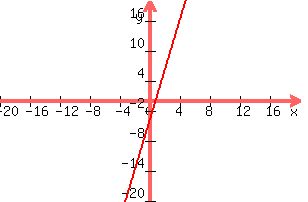Question 202423: State the domain of the following and provide a brief explanation of the answer.
m(x)=5/x^2-9
l(x)=5x-4
g(x)=7x=4/x=4
Found 2 solutions by dyakobovitch, jsmallt9:
Answer by dyakobovitch(40)   (Show Source): (Show Source):
You can put this solution on YOUR website! To find the domain of a function, it is most appropriate to create a graph. Domain satisfies the bounds for the x-axis, or the horizontal movement of the graph.
M(x)=5/x^2 - 9 is a rational function with the following graph:  , so the domain is (-∞,∞). , so the domain is (-∞,∞).
L(x)=5x-4 is a linear equation with the graph:  . As seen in the graph, it is a line that has no bounds in the Cartesian Coordinate plane. . As seen in the graph, it is a line that has no bounds in the Cartesian Coordinate plane.
Its domain is (-∞,∞).
G(x)=7x=4/x=4. If you can clarify the equation I can help you, but this is clearly not a function since there are three equal signs.
Answer by jsmallt9(3758)   (Show Source): (Show Source):
You can put this solution on YOUR website! The domain of a function is the set of all possible values for the input variable, which is usually "x". Generally, when a domain is not explcitly defined, the domain of a function is all Real numbers. However, one must exclude values which cause expressions which cannot be allowed.
Examples of expressions which cannot be allowed:- Division by zero
- Negative radicands of even-numbered roots:
 Since there are no square roots of negative numbers (within the set of Real numbers) the domain of g must ensure that (x+3) >= 0. In other "words", x >= -3. Since there are no square roots of negative numbers (within the set of Real numbers) the domain of g must ensure that (x+3) >= 0. In other "words", x >= -3. . Since there are no 6th roots of negative numbers (within the set of Real numbers) the domain of h must ensure that (3x - 6) >= 0. In other "words", x >= 2. . Since there are no 6th roots of negative numbers (within the set of Real numbers) the domain of h must ensure that (3x - 6) >= 0. In other "words", x >= 2.- Note that
 has a domain of all real numbers since cube roots (in fact all odd-numbered roots) of negative numbers do exist within the set of Real numbers. has a domain of all real numbers since cube roots (in fact all odd-numbered roots) of negative numbers do exist within the set of Real numbers.
- Negative or zero agruments to logarithm functions (regardless of the base of the logarithm).
- Arguments which are not allowed by certain other functions which are part of the definition of the function in question. An example of this would be f(x) = tan(x) + 4. Since the tan function is not defined for 90 degrees (or
 radians), these values must be excluded from the domain of f(x). radians), these values must be excluded from the domain of f(x).
Now let's apply this to your problems.

Since we have a denominator we must avoid x-values that would make the denominator zero. So if we solve  we will find the x-values we must exclude from the domain. Factoring this equation we get we will find the x-values we must exclude from the domain. Factoring this equation we get  . From this we can see that the solution is x = 3 or x = -3. . From this we can see that the solution is x = 3 or x = -3.
So the domain of m(x) is all real numbers except 3 and -3.
l(x)=5x-4
Since none of the items described above (denominators, even-numbered roots, logarithms, etc.) are present, there is nothing to exclude. The domain is all Real numbers.
g(x)=7x=4/x=4
With 3 equal signs I'm not sure what this is. Since the "=" and the "+" are on the same key, I'm going to assume that the last two "=" are supposed to be "+".
If  we must make sure the denominator of x does not become zero. So we must exclude 0 from the domain. we must make sure the denominator of x does not become zero. So we must exclude 0 from the domain.
If instead  then we must make sure (x + 4) is not zero. So x must not be -4. then we must make sure (x + 4) is not zero. So x must not be -4.
|
|
|